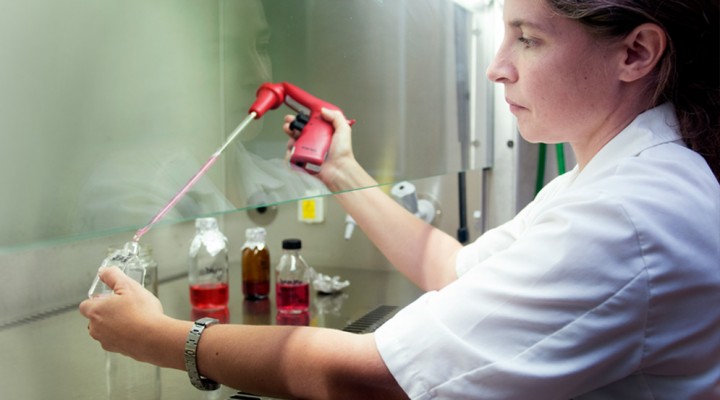BIOLOGICAL AND HEALTH SCIENCES
Virest’s new activity
CONICET scientists patented this compound that not only acts as an antiviral and anti-inflammatory, but also inhibits the formation of blood vessels, a key process in tumor development.
In 2014, due to the study on Virest, the INNOVAR Prize in Applied Research and the INNOVAR Distinción were awarded to Laura Alché, CONICET independent researcher at the Institute of Biological Chemistry of the Faculty of Exact and Natural Sciences of the UBA (IQUIBICEN, CONICET-UBA), and her team of virologists and organic chemists at the Faculty of Medicine of the UBA. Virest, this molecule prototype, belongs to a family of more than forty members and has a dual activity: antiviral and anti-inflammatory, and for this reason it has a potential application in the treatment of eye diseases such as viral conjunctivitis. Due to these characteristics, it was patented in the US.
“For many years we have studied natural compounds of plant origin that had dual activity: they were antiviral and had cytoprotective effect – they protect the cells-. This motivated us to work with Javier Ramírez, CONICET independent researcher at the ‘Unity of Microanalysis and Physical methods in Organic Chemistry’ (UMYMFOR, CONICET-UBA) and Lydia Galagovsky of the ‘Organic Chemistry Department’ (FCEyN-UBA), and think about the importance of having a molecule with a well-known structure capable of concentrating these two activities. They had synthesized brassinosteroids analogues, plant hormones, and found that they had antiviral activity. It was then that we thought about the development of a molecule capable of concentrating both activities in its structure because it has a skeleton similar to corticosteroids, which are anti-inflammatory, and retain antiviral activity found in brassinosteroids. So that was how Virest emerged”, the researcher comments.
Recently, the scientists informed that this molecule also has anti-angiogenic activity so they obtained another patent in the US. Virest’s capacity of inhibiting the growth of blood vessels might involve a potential use in tumor treatments. Tumor cells, as all cells, need oxygen and nutrients to survive so their growth and development depends on good vascularization, that is to say, of the formation of new blood vessels from the already existing ones. These vessels serve tumor cells to spread and metastasize.
“With Alejandro Berra of the Faculty of Medicine (UBA) we carried out the in vivo tests of herpetic keratitis in mice and it was there that we found the possible anti-angiogenic activity. One of the signs of this disease is the corneal neovascularization, that is to say, the appearance of new vessels in this outer layer of the eye. When Virest was present, the neovascularization decreased. Through the in vitro tests, the idea that the molecules could have anti-angiogenic activity emerged. The Virest was active and showed anti-angiogenic activity in endothelial cells, which grow in a matrix to form the simile structure vessels” Flavia Michelini, CONICET assistant researcher at the Institute of Biological Chemistry at the Faculty of Exact and Natural Sciences of the UBA (IQUIBICEN, CONICET-UBA) and part of Alché’s team explain.
Michelini says that the final effect is that the vessels remain completely unarmed in the presence of the molecule. Virest can also decrease the levels of vascular endothelial growth factor (VEGF), which is an angiogenic mediator and a vascular permeability stimulator, therefore, a very significant factor for the growth of the blood vessels.
Some molecules that are part of Virest family and were tested did not show anti-angiogenic activity. This is a relevant result because the anti-angiogenic activity could have been a consequence of the anti-inflammatory activity that had already been reported and a characteristic of this family of molecules. The fact that within the same Virest family there might be some compounds that work as anti-inflamatories but might not have anti-angiogenic activity, reinforces the theory that this is a new activity that Virest has per se.
“We know that Virest acts on cells that affect intracellular signaling pathways. This could explain the anti-inflammatory and anti-angiogenic activity. Probably, as it affects the signaling pathways involved maybe in more than one effect, it could be beneficial for the treatment of human diseases of different etiologies. Our expectations as regards this is that these compounds can be used efficiently as antiviral and anti-inflammatories. Besides, we hope someday we can use these drugs to collaborate to treat tumors, but we are still far from that”, Alché concludes.
All these lines of research and finds are part of a research and development agreement with the Instituto Massone S.A. through CONICET. The Council is the owner of the patents and the Laboratory is the license holder for a fixed period of time.
“The greatest part of the investment was made by the State through subsides of CONICET, ANPCyT and the UBA. The results are the product of more than fifteen years of work. The Council is committed to innovation through public-private agreements”, Alché comments.
About the study:
Javier Alberto Ramírez. Independent researcher. UMYMFOR (CONICET-UBA).
Laura Alché. Independent researcher. IQUIBICEN (CONICET-UBA)
Flavia Michelini. Assistant researcher. IQUIBICEN (CONICET-UBA).
Lydia Raquel Galagovsky. FCEyN-UBA.
Alejandro Berra. FMED-UBA.
By Cecilia Leone.
